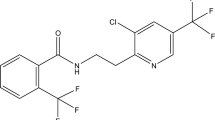Abstract
Quinclorac is a selective herbicide commonly used in China to control monocotyledonous weeds in paddy fields. A field experiment was conducted to quantify the environmental behavior of quinclorac in acidic paddy soil under rice (Oryza sativa L.) field conditions, and to evaluate the risk of its residues to the subsequent crop of tobacco (Nicotiana tabacum L.). Rice was sprayed once with quinclorac 50% WP at 562.5, 375.0, or 187.5 g a.i. ha−1 at 7 days after transplanting the seedlings. Decay of quinclorac in paddy field soil followed first-order kinetics, with a half-life of 28.29–30.27 days. At harvest time, 0.090, 0.074 and 0.034 mg kg−1 of quinclorac were found in soils following the above-described treatments, respectively. Leaves of the subsequent crop, tobacco, sown the year after the quinclorac treatments, exhibited different dose-dependent degrees of visible phytotoxicity symptoms.

Similar content being viewed by others
References
Chen ZP, Deng JC, Wan SQ, Wang J, Zhan ZS (2007) Detoxication of some chemicals for deformity of tobacco by quinclorac. Ecol Environ Sci 16(2):453–456
Chism WJ, Bingham SW, Shaver RL (1991) Uptake, translocation and metabolism of quinclorac in two grass species. Weed Technol 5(4):771–775
European Commission (2006) Directorate general health and consumer protection, guidance document on quality control procedures for pesticide residues analyses, SANCO/10232/2006. http://www.ec.europa/food/plant/protection/resources/publications_en.htm. Accessed September 2006
Grossmann K (1998) Quinclorac belongs to a new class of highly selective auxin herbicides. Weed Sci 46(6):707–716
Grossmann K, Kwiatkowski J (1995) Evidence for a causative role of cyanide, derived from ethylene biosynthesis, in the herbicidal mode of action of quinclorac in barnyard grass. Pestic Biochem Physiol 51(2):150–160
Grossmann K, Kwiatkowski J (2000) The mechanism of quinclorac selectivity in grasses. Pestic Biochem Physiol 66(2):83–91
Guo JH, Liu XJ, Zhang Y, Shen JL, Han WX, Zhang WF, Christie P, Goulding KW, Vitousek PM, Zhang FS (2010) Significant acidification in major Chinese croplands. Science 327:1008–1010
Hill BD, Moyer JR, Inaba DJ, Doran R (1998) Effect of moisture on quinclorac dissipation in Lethbridge soil. Can J Plant Sci 78(4):697–702
Lamoureux GL, Rusness DG (1995) Quinclorac absorption, translocation, metabolism, and toxicity in leafy spurge (Euphorbia esula). Pestic Biochem Physiol 53(3):210–226
Lovelace ML, Hoagland RE, Talbert RE, Scherder EF (2009) Influence of simulated quinclorac drift on the accumulation and movement of herbicide in tomato (Lycopersicon esculentum) plants. J Agric Food Chem 57(14):6349–6355
Miao H, Yang XJ, Cheng DD, Duan C, Feng L, Zhou LJ, Xu HH (2014) Effects of environmental factors on the degradation of quinclorac in soil. J Nanjing Agric Univ 37(4):144–148
Pinna MV, Pusino A (2012) Direct and indirect photolysis of two quinolinecarboxylic herbicides in aqueous systems. Chemosphere 86(6):655–658
Resgalla C Jr, Noldin JA, Tamanaha MS, Deschamps FC, Eberhardt DS, Rörig LR (2007) Risk analysis of herbicide quinclorac residues in irrigated rice areas, Santa Catarina, Brazil. Ecotoxicology 16(8):565–571
Sterling TM (1994) Mechanisms of herbicide absorption across plant membranes and accumulation in plant cells. Weed Sci 42(2):263–276
Sunohara Y, Shirai S, Wongkantrakorn N, Matsumoto H (2010) Sensitivity and physiological responses of Eleusine indica and Digitaria adscendens to herbicide quinclorac and 2,4-D. Environ Exp Bot 68(2):157–164
Wang YR, Liu CW, Niu CY, Liu XW, Jiang QY (1996) The dissipation and residue of quinclorac in rice field water, soil and rice plant. Environ Sci 17(1):27–30
Wuerzer B, Berghaus R (1985) Substituted quinolinecarboxylic acid-new elements in herbicide systems. In: Proceedings of the 10th Asian Pacific Weed Science Society Conference, pp 177–184
Acknowledgements
This work was supported by the Science and Technology Planning Project of Jiangxi Province (No. 20142BBF60049) and China National Tobacco Corporation Jiangxi Branch (No. 201601007). We thank International Science Editing (http://www.internationalscienceediting.com) for editing this manuscript.
Author information
Authors and Affiliations
Corresponding author
Rights and permissions
About this article
Cite this article
Zhong, Q., Wan, S., Shen, C. et al. Decay of Quinclorac in Acidic Paddy Soil and Risk Evaluation to the Subsequent Crop, Tobacco (Nicotiana tabacum L.). Bull Environ Contam Toxicol 101, 284–287 (2018). https://doi.org/10.1007/s00128-018-2372-y
Received:
Accepted:
Published:
Issue Date:
DOI: https://doi.org/10.1007/s00128-018-2372-y




